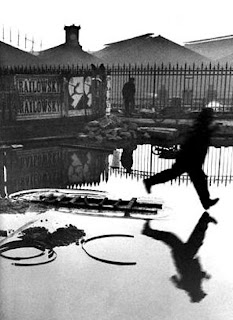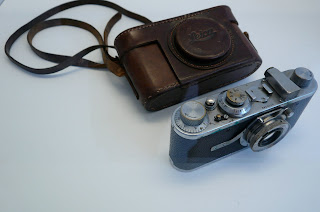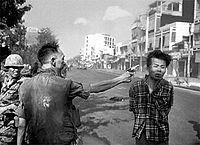Henri Cartier-Bresson
(1908 - 2004)
He's talked about as one of the grates photographers of his time, Henri Cartier-Bresson a French photographer, is thought to be the father of modern photojournlisim.
He used a technique called the decisive moment. The decisive moment is when you take a picture at the right moment, if Bresson was either a moment too late or a moment to early then he would not of achieved one of the most well known photo's, Behind the Gare Saint-Lezare in 1932.
 In this photo a male has come across a puddle and has no other option then to jump over it, if this photo was taken a moment later it would not have the same affect, as it would look like the man's only walking. Capturing this picture while this man was jumping gives this photo more dynamics.When he took this photo he had to make sure that he got every aspect in, including the background and the main object, with full focus.
In this photo a male has come across a puddle and has no other option then to jump over it, if this photo was taken a moment later it would not have the same affect, as it would look like the man's only walking. Capturing this picture while this man was jumping gives this photo more dynamics.When he took this photo he had to make sure that he got every aspect in, including the background and the main object, with full focus. Many people think that his work was just down to luck but in fact he would sit around for hours wait for the perfect picture. The critics hated bresson, they slated him and called him no more than 'a snapshooter' in some ways they could be right, but if another photographer did the same technique as Bresson, the quality of the photo would not be the same.
 Bression was one of the first people to own a Leica, as a wealthy man he brought one as soon as they came out, he then automatically started photo's with it. The world opened up too him through a 35mm lense.
Bression was one of the first people to own a Leica, as a wealthy man he brought one as soon as they came out, he then automatically started photo's with it. The world opened up too him through a 35mm lense. war and photography
 Eddie Adams (1933-2004) was a prize winning photographer, he took some of the most well known photo's, such as the execution of Nguyễn Văn Lém in 1968. Photojournalism can be very deceiving, because you dont always get the full image, you need some background for the image to make sense.
Eddie Adams (1933-2004) was a prize winning photographer, he took some of the most well known photo's, such as the execution of Nguyễn Văn Lém in 1968. Photojournalism can be very deceiving, because you dont always get the full image, you need some background for the image to make sense. This is the image of Nguyễn Văn Lém being excuted in 1968. He was guilty of only stealing food and did not have a trial. He was taken too Nguyen Van Lem, also known as Captain Bay Lop where he was shot in the head, he died from a single bullet.
 Diane Arbus
Diane Arbus(1923 - 1971)
she was a famous american photographer, shes mostly known because of the portriate that she done on the Matthaei family in 1968. The Matthaei family agreed to have their photo taken by Dian, they usually had their photos taken by a male photographer, she was a risky choice but as she was free they decided to chose her instead. Her work was unique, she got a different angle to the family that many people had never see before, the daughter of this family said "her work didnt fatter anyone but it was good."
One of Diane Arbus's friends said that she was scared to be known as the photographer of freaks, however this is the most common way that Diane's work is discribed. The fear off her being seen as a a freak took over her and she commited suiced in 1971, aged only 48.
 Larry Clark
Larry Clark(1943)
 Best known for his book called Tulsa which focused on underage activities such as sex, drinking, drug usage and violence. This book was full off black and white images which were all taken in Tulsa, Oklahoma. The photo's were taking between the period of 1963-1971 when Larry was a drug addict. The book was published late 1971, it caused a sensation of shock and horror within the photographic community.
Best known for his book called Tulsa which focused on underage activities such as sex, drinking, drug usage and violence. This book was full off black and white images which were all taken in Tulsa, Oklahoma. The photo's were taking between the period of 1963-1971 when Larry was a drug addict. The book was published late 1971, it caused a sensation of shock and horror within the photographic community.Walker Evans
(1903 -1975)
Well known for his work for the Farm security Administration documenting the effects of the Great Depression. Most of his photo's were focused on the poor and vulenrable, he captured their real emotions and day to day life unlike most photographers, many photographs when doing portrates would tell the people they were photographing how to feel, but he didn't.